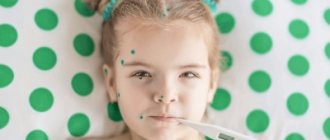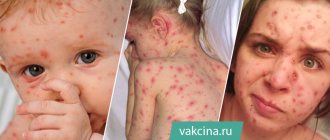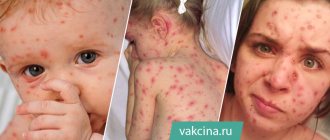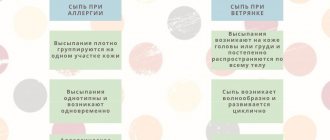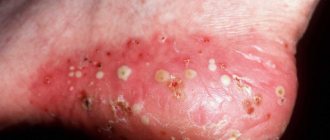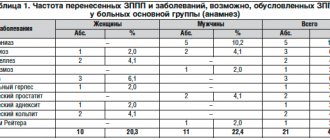Chicken pox is an infectious disease. It occurs as a result of entry into the body and rapid reproduction of one of the strains of the herpes virus - ꓦаricella Zоster. The disease is highly contagious, that is, the pathogen is easily transmitted from an infected person to a healthy person. Typically, infection occurs through airborne droplets, less often through household contact. A characteristic feature of the disease is its acute course: patients experience a sharp increase in body temperature, symptoms of intoxication of the body, a papular itchy rash, etc. After recovery, the vast majority of patients develop immunity to this infection, which lasts for life. For a long period of time, it was believed that one should not wash during chickenpox, as this increases the number of vesicles on the human skin. However, today it has been established that during the normal course of the disease, sanitary and hygienic procedures have a beneficial effect on the patient’s condition.
Attention!
Vesicles are small fluid-filled formations on the epidermis, formed as a result of the development of the inflammatory process. The vesicles may be filled with clear cerebrospinal fluid, greenish or yellowish purulent effusion, or blood.
Features of the course of the disease
Chickenpox is a manifestation of the reaction of the human immune system to the penetration of the microorganism ꓦаricella Zоster into the body. Due to its high invasiveness, the disease is most often transmitted by children of preschool or primary school age. The virus then enters the circulatory system through the epithelial membranes of the respiratory tract.
With the normal development of the disease, several main stages are distinguished during its course:
- Infection and latent or incubation period
. At this time, the pathogen integrates into the cells of the epithelial membranes of the upper respiratory tract and infects them. No clinical symptoms are expressed at this stage, the patient does not complain of deterioration in health. - The period of appearance of the first symptoms of the disease
. A huge number of viruses and virions spread through the bloodstream throughout the patient’s body. Infection is accompanied by characteristic symptoms of intoxication: the patient’s health sharply worsens, a feeling of weakness occurs, headache, myalgia and arthralgia appear. In response to a viral attack, the immune system begins to produce antibodies to the pathogen. - Acute period
. Any herpes virus, including the causative agent of chickenpox, is embedded in the roots of the nerve ganglia. The result of this process is the appearance of a characteristic papular rash on the skin and mucous membranes. The rashes can itch and cause severe discomfort to the patient, but with proper care they dry out and disappear after 2-4 weeks, leaving no scars. - Recovery stage
. The rash on the epithelium and epidermis dries out, becomes crusty, and the patient’s general condition noticeably improves.
After suffering from chickenpox, a person most often develops immunity to this type of virus, which usually lasts from several months to tens of years.
Features of clinical symptoms of chickenpox
| Signs | Features of the flow |
| Rash | Vesicular or papular, evenly distributed over the entire surface of the skin |
| Hyperthermia | Up to 39-39.5°C |
| Symptoms of intoxication | Headache, weakness, excessive sweating, drowsiness |
| Acute disturbance of well-being | Lasts from 3 to 7 days on average |
Symptoms of chickenpox in children
How quickly do signs of chickenpox appear in a child after contact with a sick person? This can happen throughout the entire incubation period of the disease - 1-3 weeks. The beginning is always sharp:
- increase in body temperature to critical values;
- severe weakness, constant drowsiness;
- headaches that appear with a certain frequency and are not relieved by painkillers.
The initial stage of chickenpox looks the same in children and adults, but in the latter it is more acute - aggressive hyperthermia and a semi-fainting general condition. The main sign of the disease is a characteristic rash - small pimples with liquid contents localized mainly on the head and torso. Most often the face and scalp, chest and décolleté are affected, and less commonly the buttocks, limbs and perineum. The rash is characterized by severe itching, which is very difficult to tolerate - even if during the day the patient somehow restrains his impulses, then at night he begins to scratch the skin uncontrollably.
The rash appears and spreads very quickly - first a red spot with slight swelling forms, then blisters form at this place, which, as the disease progresses, transform into ulcers, crust over and disappear. There is a wave-like course of infection, so rashes may appear and disappear periodically.
Hygiene for chickenpox
Chickenpox is a long-term disease. In general, from the moment the first symptoms appear until the rash completely disappears, it takes from 14 to 35 days. At the same time, due to the rash, patients experience severe itching and discomfort. Observing the rules of personal hygiene during illness helps relieve discomfort and improve the patient’s condition.
Attention!
If there are no complications with chickenpox, then water procedures are necessary, especially after the body temperature has normalized. Washing makes it possible to cleanse the skin of accumulated dirt, sweat and skin secretions, thereby speeding up recovery.
When can you wash yourself if you have chickenpox?
You can take a shower with chickenpox after the end of the acute phase of the disease. As a rule, improvement in well-being occurs 3-5 days after the first symptoms of illness appear. Experts recommend performing water procedures only if the patient’s body temperature does not exceed 36.6-36.9°C.
- During the day, the patient is allowed to wash his hands and feet if necessary with warm water, antibacterial soap or gel. In this case, after the procedure, each vesicle should be treated with brilliant green, fucorcin ointment, Tsindol, etc.
- Small children can be washed several times a day, but drying their skin with a towel is not recommended. Disposable wipes or absorbent diapers should be used. After the procedure, calamine lotion can be applied to the skin. It soothes the skin and relieves itching.
- Adult patients may shower for 2 to 5 minutes at a low-grade fever, not exceeding 37.5°C, if they experience severe itching due to severe rash and accumulated secretions and debris on the skin.
Washing for chickenpox
There are several recommendations that must be followed when performing hygiene procedures for patients suffering from chickenpox:
- Taking a shower for the first time during illness should not last more than 3-5 minutes. If dizziness, tachycardia or weakness occurs, you should stop washing.
- You should not use gels, scrubs or other cosmetic care products while washing for the first 10-12 days after the onset of symptoms of the disease.
- The head and body must be washed separately.
- Taking a bath is allowed only if the patient does not complain of any health problems other than a rash. Typically, this condition occurs after 5-6 days of illness. It is worth considering that foams or lotions cannot be added to bathing water; decoctions of medicinal plants are allowed for use.
- You cannot use a washcloth until the crusts fall off from the vesicles.
Washing your hair for chickenpox
If you have chickenpox, you can wash your hair only after the rash on the skin begins to dry out. At the same time, this procedure should not be postponed for too long, since otherwise sebum secretions and dust accumulated on the hair can lead to contaminants entering the opened papules and the development of the inflammatory process. Most often, washing your hair is possible on the 5-10th day of illness. It is recommended to do this as follows:
- Hair should be washed in a basin filled with warm water and decoctions of oak bark, chamomile or calendula. These infusions help relieve itching, improve skin condition and gently cleanse it.
- Shampoos or soap solution should not be used for hygiene procedures. You should also not treat your hair with balm, since cosmetic products lead to rapid contamination of the head.
- Water procedures should not last more than 10-15 minutes. At the same time, the bathroom should be warm so that the patient does not become hypothermic.
- After washing, gently dry your hair using blotting movements. Do not dry your head thoroughly, as it may damage the rash. After each wash, the towel must be disinfected and washed. Repeated use may lead to additional spread of infection.
- The scalp must be treated with a drying and disinfectant, carefully lubricating each papule.
- Shampoo and other detergents should only be used after the crusts formed on the vesicles have fallen off.
Video - In what water can you bathe a child with chickenpox?
When can you bathe your baby?
- If there is no high temperature.
- The baby doesn't mind taking a bath.
- The disease occurs without pustules, there are no secondary infections on the skin.
If the child is weakened and categorically against bathing, wait a few days. 3-5 days after the rash, the disease subsides and the mood improves.
Important! 1-2 days of illness development are not suitable for swimming in most cases. The baby has a fever, is capricious, lies in bed, and the disease is actively developing. These days, it is enough to wipe it with a disposable wet napkin, wash it after using the toilet, and wash your face after eating.
3-5 days after the first rash, when a crust begins to form on the papules, you can completely bathe the child or take a light shower.
And here is what Dr. Komarovsky thinks about this:
Contraindications to water procedures
There are a number of contraindications in which patients with chickenpox are not recommended to take a shower or bath:
- The patient continues to have a high body temperature or has chills and severe weakness.
- The patient has a weakened immune system or has cardiovascular or kidney problems. In this case, you can take a shower on the 6-7th day of illness for 2-3 minutes.
- Secondary infections are associated with chickenpox.
In this case, water procedures should be replaced by treating the skin with special medicinal foams, herbal decoctions or wiping with wet wipes.
Chickenpox is a long-term infectious disease. During chickenpox, it is extremely important to maintain good personal hygiene. During the acute period of the disease, during which severe hyperthermia is noted, washing is not recommended. You can take a shower 3-5 days after the first symptoms of illness appear. Keeping your skin clean will reduce the symptoms of the disease and speed up recovery.
When is swimming prohibited?
The ban on swimming is imposed by doctors of the “old school”. In their opinion, baths help soften the bubbles on the body, and they should dry out. But this point of view is wrong.
The fluid in the blisters is a source of infection. The child scratches them and spreads the infection across the skin. If you follow the rules for taking baths for children with chickenpox, the bacteria are washed off the body and the infection does not spread to healthy areas.
There are only a few situations in which full baths are prohibited:
- The child’s well-being does not allow it. He is very ill, his temperature is elevated.
- There are pustules on the skin. In other cases, bathing is beneficial for babies and speeds up recovery.
Benefits of bathing
In most cases, the illness lasts for 7 days. The lack of water procedures during this period can aggravate the course of chickenpox. Severe itching leads to the fact that a child or adult begins to actively itch, and pathogenic microorganisms that quickly multiply on a dirty body can penetrate the wounds, causing infection.
Bathing cleanses the skin, which reduces the risk of infection. Also, bathing with chickenpox makes it possible to reduce irritation and help eliminate itching.
Recommendations for parents
Take advantage of the useful advice from pediatricians and other parents so as not to make mistakes when bathing and not harm the baby:
- The bath water temperature should not exceed 37°C.
- Wash the babies in boiled water, adding herbal infusions and a weak solution of potassium permanganate.
- Rinse children from one year old in the shower 3-5 times a day, use a bath with herbs before bed.
- Do not allow the patient to remain in the water for too long. 3-5 minutes is enough.
- Use your palm to wash.
- Do not wipe your baby's body dry. Let the moisture absorb into the skin.
- It is better to wash your baby after each trip to the toilet. There may also be chickenpox rashes on the genitals and near the anus. If you do not keep the intimate area clean, irritation begins there and a secondary infection occurs.
- After a shower, put on clean underwear, lubricate the papules with fucorcin, brilliant green, and healing ointments.
- Wipe rashes on the mucous membrane with a soft swab, cotton pad, and dab in chamomile decoction.
Important! If you decide to rinse your baby in the shower, watch the strength of the stream. It should be soft and not damage the rashes that have already begun to dry out.
Visiting the bathhouse and swimming in the sea with chickenpox
Visiting the bathhouse during illness is prohibited. You are allowed to walk only 2-3 weeks after completion of treatment. The skin needs time to recover from the infectious process. A trip to the bathhouse is fraught with additional damage, burns, and age spots.
Is it possible to swim in the sea if you have chickenpox? Both children and adults can swim in the sea. The sea is a natural antiseptic that promotes rapid regeneration of the skin, ensuring improved overall well-being. However, it is better to be careful, as there is a certain risk of infection that will penetrate through open wounds on the body.
A properly organized bathing process and compliance with all recommendations is a significant aid to the body, facilitating rapid recovery.
